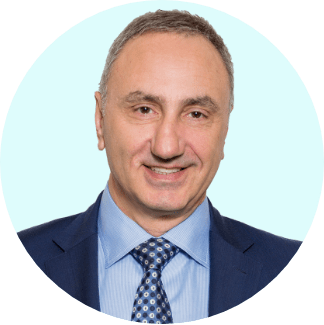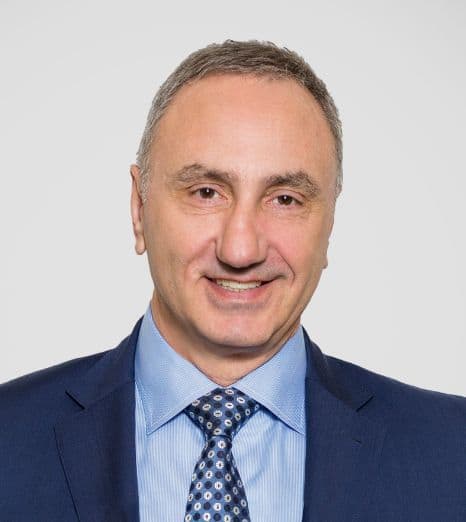State of The Plan
Chris Kautzky, Chief Investment Officer, and Peter Shena, Chief Pension Officer, together with the rest of our leadership team, play vital roles in securing the long-term sustainability of the Plan and ensuring that OPB will meet the needs of our members – today and tomorrow.


How did OPB’s investments perform in 2022?
Chris Kautzky: In 2022, financial market performance was impacted by a rapid rise in global inflation that led many central banks, including those in Canada and the United States, to significantly raise interest rates throughout the year, which resulted in both stocks and bonds underperforming. Financial markets were also worried about the impact of increasing geopolitical tensions, most notably the Russian invasion of Ukraine, which affected energy and commodities markets and exacerbated ongoing supply chain disruptions, driven primarily by the lasting impact of COVID-19 on China. All these factors fuelled concerns about a potential global recession, which then reinforced negative financial outcomes. Fixed income investments performed quite poorly as bond yields rose dramatically and credit spreads widened. Historically, fixed income assets have been a safe harbour when equities struggled, but that was not the case in 2022.
Our portfolio is highly diversified, so a decline in one asset class is often offset by the positive performance of other assets. In 2022, our private market assets outperformed both publicly traded equities and bonds, highlighting the benefit of the increase in our allocation to these assets over the past several years.”

While the correlation of underperformance of both equities and fixed income investments was unusual, OPB was well positioned to manage this impact. Our portfolio is highly diversified, so a decline in one asset class is often offset by the positive performance of other assets. In 2022, our private market assets outperformed both publicly traded equities and bonds, highlighting the benefit of the increase in our allocation to these assets over the past several years. Another positive contributor in 2022 was the portfolio’s relative performance versus the Plan’s benchmark, reflecting good portfolio management by Investment Management Corporation of Ontario (IMCO).
How will 2022 impact the Plan’s long-term sustainability?
Chris Kautzky: Looking back at 2022, it is essential to keep in mind that the nature of investing the assets of the Public Service Pension Plan (PSPP) is long term. Performance over a single year is important, but the real story is how a portfolio performs over the long term. From that perspective, the Plan has enjoyed an average return of 6.2% and outperformed its benchmark by 0.2% over the last 10 years.
Given the funded status of the Plan, should I be worried? Will my pension still be there when I retire?
Peter Shena: Our role as the administrator of the Plan is to focus on the long term. We have faced challenging situations in the past and we will again. We have weathered these well. Since inception the Plan has had a strong long-term return of 7.6%. That said, we have a 10-year funding plan in place to restore the Plan to full funded status. We must and will continue to stay focused on the long term.
How did OPB manage its investment strategy in 2022?
Chris Kautzky: OPB establishes the investment guidelines for IMCO, our investment manager, through our Strategic Asset Allocation (SAA), which sets out what investment classes OPB will invest in and to what degree. We began transitioning to our current long-term SAA at the end of 2021. As part of that transition, we introduced two new elements to our SAA: absolute return strategies, which IMCO calls public market alternatives (PMA), and portfolio leverage, which is intended to improve the Plan’s risk-adjusted returns. A defining feature of absolute return strategies and alternative assets is that they are less correlated to public market performance than equities. Additionally, they can diversify an investment portfolio, which tends to mitigate risk. While it’s early days, the changes we implemented in our SAA turned out to be well timed. The PMA strategy performed better than most other strategies in 2022 and the addition of leverage provided greater flexibility in managing the portfolio during periods of market stress.
Given the volatile market conditions in 2022, we undertook an interim review of the SAA to ensure the long-term projections underpinning the strategy remained relevant. In addition, the market conditions also permitted some of our long-term asset class allocations to be achieved faster. We will continue to review our strategy in 2023 to ensure it remains current within a rapidly evolving capital markets environment as well as reflecting IMCO’s latest World View.
How does IMCO create value for PSPP members?
Chris Kautzky: IMCO began managing funds on behalf of OPB and other clients in 2017. Now in its sixth year of operation, IMCO is continuing to establish itself as a trusted investment manager and is using its scale to pursue opportunities that OPB would not be able to do independently. This includes building a highly skilled investment team with a wide range of specialties, developing a comprehensive risk management program and managing complex asset classes and investment strategies internally. IMCO has also had notable success in partnering with leading investment managers, particularly in private assets, which comprise an increasingly significant portion of the Plan’s asset mix. As part of OPB’s oversight role, we regularly evaluate IMCO’s performance and the value it provides as our investment manager.
Now in its sixth year of operation, IMCO is continuing to establish itself as a trusted investment manager and is using its scale to pursue opportunities that OPB would not be able to do independently. This includes building a highly skilled investment team with a wide range of specialties.”

What progress has OPB made when it comes to Environmental, Social and Governance (ESG) issues?
Chris Kautzky: OPB collaborates with IMCO on the consideration of ESG issues that affect our investment performance. For that reason, our progress needs to be viewed collectively. Over the past few years, OPB and IMCO have made significant progress in developing an ESG strategy, establishing effective policies and procedures and executing against our combined objectives.
In 2022, OPB and IMCO’s key ESG achievements and developments included:
- IMCO completed a baseline analysis of its investment portfolio’s carbon footprint and including those findings in its first ESG annual report;
- IMCO announced its interim targets for reaching net-zero carbon emissions by 2050 or sooner;
- OPB updated our ESG action plan to guide our activities over the next few years;
- OPB received our initial United Nations Principles for Responsible Investing (PRI) assessment; and
- OPB advanced our ESG communications strategy, and we expect to release our inaugural ESG report by early 2024.
What progress did OPB make on pension and technology modernization in 2022?
Peter Shena: Guided by client feedback, in 2022 we continued with our modernization journey by enhancing the member and employer portals that we introduced in 2021, including a refresh of our Retirement Planner. The changes we made in recent years to our development approach have made us more agile and better able to rapidly respond to meet clients’ needs. Our online services are now mobile responsive and work effectively across devices, while remaining compliant with the Accessibility for Ontarians with Disabilities Act (AODA), which means our services are available equally to all members. To keep our members’ data and privacy safe, we adopted multi-factor authentication (MFA), a method for securing data in which a client has to provide two or more credentials to verify their identity. Unavoidably, this introduced an extra layer to the login process, but we believe this move was essential to deliver the security level required to protect our members' personal and pension information. Through our Client Services team, we offered valuable support to help members understand and adapt to this new approach.
In 2022, we continued with our modernization journey by enhancing the member and employer portals that we introduced in 2021, including a refresh of our Retirement Planner. The changes we made in recent years to our development approach have made us more agile and better able to rapidly respond to meet clients’ needs.”

The progress we've made so far will provide us with an agile technical foundation that will allow us to meet our clients’ needs as they continue to evolve. To help support the transition to a home/office work model, we introduced the OPB Hybrid Workplace Program and implemented enhanced hybrid meeting technology to enable employees and Board members to collaborate effectively and securely with their colleagues.
We experienced a significant increase in enrolment and demand for service in 2022. While this was occurring, we were understaffed and working to onboard close to one-third of our staff, who were either new or newly promoted. Despite these challenges, we continued to make progress towards replacing our legacy Benefit Entitlement Calculators and Rules engine. These important initiatives will help us automatically integrate and update data across applications, which in turn will eliminate duplication and minimize the potential for error. As a result, our clients and staff will achieve consistent results, regardless of which pension calculation they access. It will also give our platform the scale and agility necessary to handle multiple plans or complex member rules. Looking ahead to 2023, we will continue to advance our modernization initiatives.
Driven by robust enrolment and consolidation, OPB now has over 45,000 contributing members and 41,000 retired members. Adding contributing members enhances the sustainability of the Plan, but it can also increase the demand for services and support.”

How did OPB meet member needs in 2022?
Peter Shena: 2022 was an exceptional year for member enrolment. OPB added 7,000 new members to our roster (a 37% increase from the previous year), including 600 who transferred over to Ontario Health from predecessor employers who did not participate in the PSPP. Typically, the annual enrolment of new members ranges from 3,000 to 4,000. Driven by robust enrolment and consolidation, OPB now has over 45,000 contributing members and 41,000 retired members. Adding contributing members enhances the sustainability of the Plan, but it can also increase the demand for services and support.
To help meet the increased service demands, we adopted the OPB Hybrid Workplace Program, providing our staff with the equipment and technical support they needed to serve members and employers from home and the office. This included introducing systems that enabled staff to move securely and efficiently between home and work offices. We also reorganized our priorities to better serve clients with immediate requirements. Through hiring and internal promotions, we strengthened our ability to meet the evolving service needs of our members, employers and stakeholders. Onboarding, training and supporting many employees in new roles was a significant challenge for us, but we were successful. Another way we met member needs in 2022 was through the improvement of our advisor meeting bookings that enables clients to self-select an appointment with our in-house Client Services Advisors. This is one of the elements that sets us apart from other Canadian defined benefit (DB) pension plans – we have in-house Certified Financial Planners who can provide unbiased advice to help members make informed decisions about their pension.